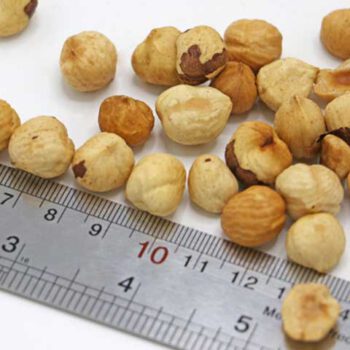
export Hazelnut
CATALOGUE
The hazelnut is the fruit of the hazel and They are also known as cobnuts or filberts according to species. The kernel of the seed is edible and used raw or roasted, or ground into a paste. The seed has a thin, dark brown skin, which is sometimes removed before cooking. Hazelnuts have a sweet flavor and can be eaten raw, roasted, or ground into a paste. Like other nuts, hazelnuts are rich in nutrients and have a high content of protein, fats, vitamins, and minerals.
Hazelnuts are a good source of vitamin E. A handful of hazelnuts (25g) contains no less than 50% of the Guideline Daily Amount (GDA). Vitamin E is a strong antioxidant.
Dried Hazelnuts are used in baking and desserts, confectionery to make praline, and also used in combination with chocolate for chocolate truffles and products such as chocolate bars, hazelnut cocoa spread such as Nutella, and Frangelico liqueur.
hazelnut PRODUCTION QUANTITY OF IRAN
Iran, with about 20000 ha hazelnut growing area and about 18000 tons annual production is the sixth hazelnut producer in the world. Guilan province(northern Iran) is the main hazelnut growing region with about 16000 ha and annual production of 11000 t in Iran.



7 health benefits of Hazelnuts
1) Full of Nutrients
Hazelnuts have a great nutrient profile. Although they are high in calories, they are loaded with nutrients and healthy fats.
- Calories: 176
- Total fat: 17 grams
- Protein: 4.2 grams
- Carbs: 4.7 grams
- Fiber: 2.7 grams
- Vitamin E: 21% of the RDI
- Thiamin: 12% of the RDI
- Magnesium: 12% of the RDI
- Copper: 24% of the RDI
- Manganese: 87% of the RDI
Hazelnuts also contain decent amounts of vitamin B6, folate, phosphorus, potassium, and zinc.
2) Loaded with Antioxidants
Hazelnuts provide significant amounts of antioxidants. Antioxidants protect the body from oxidative stress, which can damage cell structure and promote aging, cancer, and heart disease.
3) May Be Good for the Heart
Eating nuts has been shown to protect the heart. In hazelnuts, the high concentration of antioxidants and healthy fats may increase the antioxidant potential and lower cholesterol levels in the blood
Hazelnuts may increase oxidative capacity and reduce blood lipid levels, which can help reduce the risk of heart disease. They also seem to help normalize blood pressure.
4) Linked with Lower Rates of Cancer
The high concentration of antioxidant compounds, vitamin E, and manganese in hazelnuts may help decrease the risk of certain cancers, though more research is needed.
5) Could Decrease Inflammation
Hazelnuts may help prevent and decrease inflammation due to their high concentrations of healthy fats. Nevertheless, other factors are also important.
6) May Help Lower Blood Sugar Levels
Nuts, like almonds and walnuts, have been shown to help reduce blood sugar levels. Hazelnuts contain several compounds that may help lower blood sugar levels. However, the evidence is limited and their potential benefits need to be studied further.
7) Easy to Add to Your Diet
Hazelnuts can be incorporated into the diet as a healthy snack or as an ingredient in many dishes. Hazelnuts can be found whole, sliced, ground, raw, or roasted. They are commonly eaten as a snack or added to baked goods and other dishes. It’s best to eat them with the skin on.
Sepcotrading company exports the best kind of Iranian dried fruits and nuts like hazelnuts at the most affordable prices all around the world.
Contact now
FAQ
The researchers concluded that the best way to reap hazelnuts’ health benefits was to eat them every day, without increasing a person’s overall calorie intake.
It can help in weight loss. Hazelnuts are packed with good fats and dietary fibers, which help in hunger management by curbing cravings.
The growing popularity of the tree nut is the result of its nutritional benefits. Commonly known for their heart health and muscle-building benefits, hazelnuts are rich in magnesium, iron, and vitamins B and C. They are also said to help with diabetes and memory loss.
You can eat hazelnuts straight from the tree, provided you have something that can break them open. A hazelnut is ripe when its fuzzy outer husk splits and exposes its hard shell, which must be cracked open to obtain the edible kernel or nutmeat.





